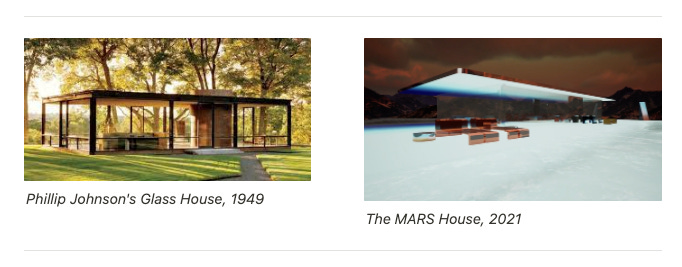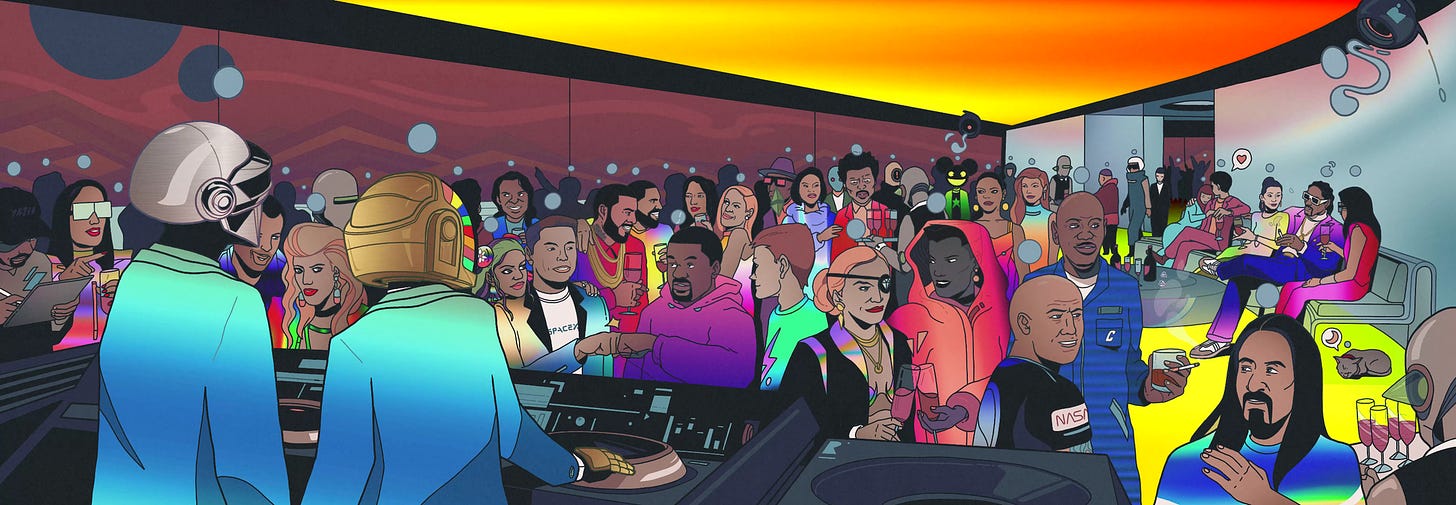Back in the bull-run of March '21, a virtual house was sold on the Ethereum network. The clickbait buzzed out of control: "now you can live in the blockchain!?"
The MARS House is an Unreal Engine scene. It contains a Philip Johnson inspired dream house, equipped with four glass walls, a gravity-defying roof, with surrounding views of a Martian ocean, gloomy mountains, and a crimson sky. It sold for 288 ETH on SuperRare ... that comes out to, approximately, a five-bedroom villa on five Kentucky acres (over five hundred thousand dollars).
It's a strange that synthetic space is selling on par with real houses, and it's most definitely the product of a delirious gold rush. Mania aside, the potential of NFT architecture isn't fully understood.
The potential of NFT architecture
Three-dimensional architecture on the blockchain represents NFTs at their peak potential: the fusion of ownership and access. The Metaverse solves the problem of digital art we've been struggling with since the arrival of Kazaa and Limewire.
Most of the NFT's we know of are JPEGs with a verification check. They're basically decentralized copyrights that you can now purchase on a marketplace. Even though anyone can copy-paste a million dollar Beeple art piece, they don't own the rights to it. We've embraced the inability to control access, and so the viral spread of pirated art is justified as marketing.
NFT architecture is different. Without the source files*, you can't recreate the experience of being in a VR scene. An NFT marketplace might show renderings of digital architecture, but that doesn't grant anyone the ability to attend an upcoming event in it. Owners can host events on their digital property, and most importantly, control who has access to them. Owning an NFT space is more than owning a copyright - it's about being the gatekeeper of semi-private space, within a new universe, one that's both digital and social (aka: the Metaverse).
💡
The artist behind the MARS House outsourced the modeling of this to someone on Freelance.com, who owns the source files, and now claims that the project is his intellectual property.
Upload to a Metaverse of Your Choosing?
So, you put on a virtual reality headset, you're on Mars, in your new half-million dollar living room, now what? The listing says that the MARS House can be "uploaded into a Metaverse of your choosing." This means, theoretically, your property is linked into a 3D social network. Your friends can teleport in and out of your Martian house party, no drunk-driving required.
Thought it seems like fiction still, there is an emerging social network that is spatial - experienced through VR headsets. Some communities are pretty hardcore, spending upwards of 8 hours a day in VR with friends, both working and playing games. Instead of freezing your ideas onto a digital bulletin board (Twitter), it's much more like being at a bar, where people communicate with their hands, and you have a peripheral awareness of everything happening in the venue.
What's missing from the MARS House listing is an important disclaimer: the Metaverse of today is very different from what it will inevitably be: "a network of real-time applications." At the moment, it's a series of standalone apps. Each network is a disconnected shard that can't speak with the others. It's not so different from the early days of the Internet. When I was in 4th grade, all of my friends had AOL, but my Dad was a Compuserve purist, making me a pariah (he eventually caved though).
There are established social scenes in VR Chat, Altsapce, Neos, Somnium Space, Decentraland, and other indie projects that are hard to keep tabs on. They don't speak well with each other, and each one has its own vibe, causing people to gravitate towards one over the others. To my knowledge, the MARS house isn't linked into any of these networks (maybe it is, and I'm just not invited to the party). A blockchain house disconnected from a network makes it more like a digital water color, a rendering of what the future of VR might look like.
Keg Stands on MARS
Execution aside, what I really like about the MARS House is that it renders a vision of VR that is unapologetically SOCIAL. So many people, ranging from Naval to CEOs of architectural technology companies, have written off virtual reality as isolating. In their defense, this stems from tech-demos that often feel like being trapped in limbo, with rubber hands, and no idea on how to escape the room.
Almost always, when someone makes "contact" in VR, with a real human, on the other side of the world, their mind is more blown than the first time they put on the goggles**.** At my last job, I was basically VR tech support, orienting architects as they met for the first time inside of their 3D models. This idea of "co-presence," the deception that you're actually in the same room with someone far away, is going to balloon in the next decade, and create a demand for virtual spaces.
An NFT, copied and pasted from SuperRate
Krista Kim (the artist behind this project), collaborated with Dirty Robot to paint a lifestyle that might one day come along with the MARS House. The collection shows how one might spend 4 days x 3 nights at a luxury villa on a virtual planet. Embedded in the art series is the story of an interstellar fling, where you get to wear one of those Daft Punk helmets at a house party, while a topless robots sits on your lap, stares into your eyes, and yokes with your soul. It's a bit too far on the Entourage meets Tron spectrum, BUT, nevertheless, I'll take it over being locked in a VR escape room by myself for an hour.
The Mars House is the "most iconic NFT house in the galaxy," and its first fictional rager features celebrities, including, but not limited to, Elon Musk, Kanye West, Vitalik Buterin, Dave Chapelle, Steve Aoki, and a resurrected Michael Jackson. Mixed into the crowd of shoulder-to-shoulder influencers are a fleet of robot slaves serving red wine.
The blue orbs above each character's head is the giveaway that the party is happening in the Metaverse. These aren't real people in a real place. These are avatars in a virtual place. They aren't actually on Mars. The DJ booth isn't real but the music is. The flirtation is real, but the couch is a 10 KB heap of polygons. We don't know if these are real celebrities embodying avatars of themselves, or if it's a kind of digital Halloween party, where regular folks live out their fantasies of fame.
Social Networks in Virtual Reality
The art above renders an elite house party, but the range of person-to-person events in VR will cover the same range as they do in real life. Sure, you can't drink, eat, smoke cigarettes, make out, or play basketball. But there's plenty of things left over.
Looking back on the past year, there's a range of experiences I've had in VR.
I spent 10 hours at virtual Burning Man last year, and met people that I since friended on Twitter. On the closing night, I gave my wife my backup headset, and we both went to a Diplo concert within a 300' glass pyramid. We were in different rooms of the house, but dancing together, flailing our arms, and sweating. There was even a creepy avatar who kept following us and trying to hit on my wife. Over 1,500 people tuned in to watch the virtual burn of the virtual man.
I met an architect who spent 4 weeks building out a mini-city for Burning Man, and she gave me a two-hour tour of all the spaces. There are communes of CG artists who basically live in a simulation and are building spaces for the flood of tourists.
I sat through an hour and a half lecture in a virtual auditorium. It was hosted through the San Francisco AR society, and featured Charlie Fink, a VR author, who I followed into the hallway after the talk, and got to have a conversation with him.
I regularly play ping-pong and mini-golf with friends and family who live around the country. The physics are surprisingly good, you don't have to chase balls, and the score is kept automatically, letting you relax and catch up. You can even play music through YouTube playlists.
At Facebook Connect, a VR conference about VR, I quickly saw Kent Bye pass by me, before jumping into a portal. He hosts a podcast on VR, and I've probably listened to a few dozen episodes. It was a strange experience to get a split second glimpse of the avatar of a niche celebrity in the virtual wild.
I've helped over 50 co-workers and clients get oriented within VR apps to move through 3D models of proposals, helping facilitate design reviews that sometimes went over 2-3 hours (the industry average length of a VR experience is 4 minutes).
All this goes to say that the simulated environments can be the context for authentic human experience. Friends, acquaintances, strangers, co-workers, and niche celebrities, who are spread out across the world, all collide in these virtual places. The experience resemble real life much more than Twitter or Zoom. I have memories that are spatial, anchored in places, and even though the avatars are cartoony in 2021, there is real laughter, body movement, and sometimes sweat.
A Frontier for Architects
The Metaverse is still an elusive beast, that might not even come in a near-final form for the next 15 years. Everything we see now is like a pre-tremor. Each phenomenon represents one facet of it, but the Metaverse itself will be the synthesis of everything into a digital layer that overlays the entirety of society (like the Internet). The implications will be greater than we can currently conceive.
Incomplete facets:
Houses on a blockchain (Mars House)
Land parcels on a blockchain (Decentraland)
Millions of people in a real-time engine at once (Fortnite)
In-game creation tools and app marketplaces (Roblox)
1,500 person festival from within a headset (Virtual Burning Man)
My experiences in social VR, even if they were part of the early, pre-AOL stage, have been enough to convince me that the Metaverse will become a part of nearly everybody's life. The MARS House, represents another kind of optimisim.
The MARS House is a rallying flag for architects. It shows that there is a potential marketplace for spatial creations. It shines light on a new business model for the crafting of space, which is struggling in the physical world. Building delivery and construction are complicated, but virtual architecture points to an industry that is social, commercial, and free from the weight of cranes, concrete, and coordination.
The creative act of architecture has been off-limits to most for centuries: it takes five years of education, seven licensing exams, and then millions of dollars to build something. In the Metaverse, the only thing limiting a nine-year old from designing a structure with the cultural clout of the Taj Mahal is their own imagination. Unlike photography, art, writing, or music, architecture is a creative craft that is rarely taken upon recreationally. The Metaverse could change that.
As the infrastructure of the Metaverse gets more and more unified, and immersive events blossom in both their quantity and quality, I think there will be a rush of NFT architecture, similar to the rush of NFT art we've experienced in the past 6 months.
The MARS House was just the first tremor.





